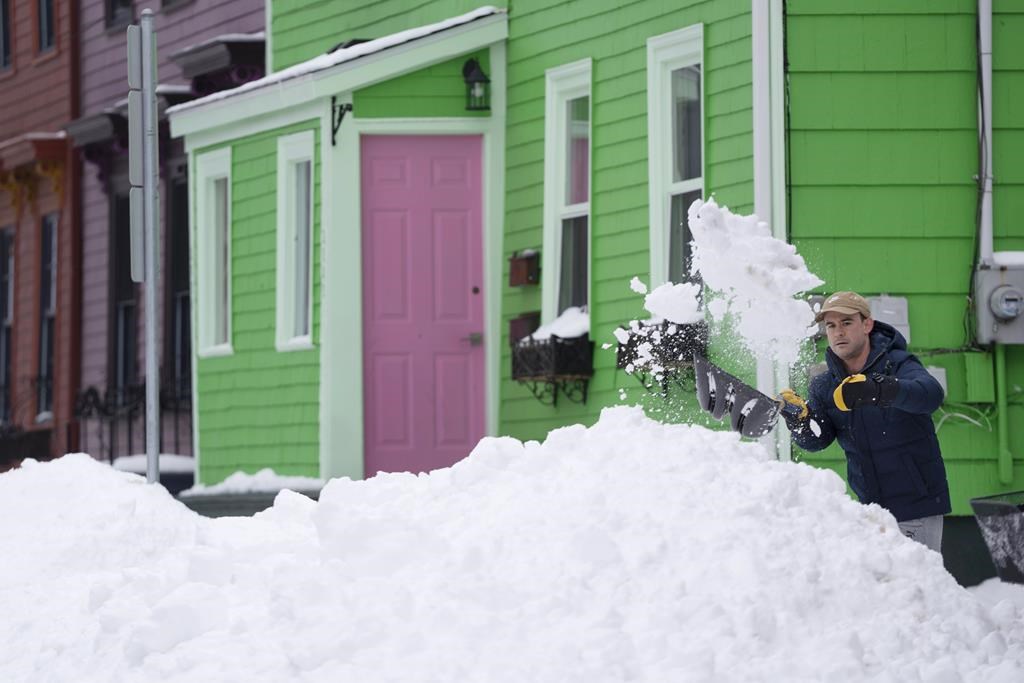Carolyn Naylor usually enjoys strolling the streets of downtown Halifax with her guide dog Earl by her side. But the routes they typically travel remain buried under mounds of snow, slush and ice nearly a week after a powerful storm pummeled much of Nova Scotia, dumping as much as 150 centimetres of snow on some regions and at least 40 on the provincial capital itself.

Such conditions complicate travel for everyone, but disabled residents say obstructed sidewalks and uncleared roadways are far more than just an inconvenience for them — they present substantial travel barriers that either leave them stranded indoors or put their safety at risk if they venture out.
And when such conditions are allowed to persist for days at a stretch, Naylor said, it leaves her and others with disabilities feel like they’re “not cared about.”
Naylor’s travels this past week have involved trying to navigate around snowbanks that tower over her, blocking key orientation landmarks and the sounds of traffic she relies on to cross the street. Slippery, narrow sidewalks leave her feeling unsafe, and her strong light sensitivity further complicates travel amid the city’s towering drifts.
“My guide dog, love him to death, he cannot constantly be on the lookout for ice. And he can’t see the ice under the snow. That’s a real danger,” Naylor said. “I can’t see ice at all until I step on it and then I’m already sliding around.”

Get daily National news
The thin pathways that have been cleared on many city sidewalks may work for some people to get around, Naylor said, but they don’t work for her and her guide dog.
“Earl will take me onto the road versus going through that little tiny path because he sometimes believes that’s safer,” Naylor said.
Disability advocate and wheelchair user Paul Vienneau said he didn’t leave his Halifax home for three days after the storm hit, and when he did emerge, he found sidewalks had only been partially cleared.
He said snow left on the edges of sidewalks will likely melt and freeze before being covered by more snow forecast to hit the province this week, resulting in conditions he describes as potentially deadly.
“That snow that’s already down there is going to get compressed, and then we’re going to have warmer days and colder days, and one cold night is all it takes then it’s black ice again,” Vienneau said.
“This is going to make it more dangerous, all over again, and for no reason,” he said, adding the potential accumulation of ice could be prevented by more thorough sidewalk clearance.
The Halifax Regional Municipality did not immediately respond to questions about sidewalk conditions and snow clearing efforts.
Vienneau said without swift action to clear sidewalks before more snow falls, people with disabilities will likely be stuck struggling to get around the city once again.
“It’s not fair to single out a group that may have to wait weeks to be able to live their lives,” he said.
Naylor, who worked entirely from home last week due to the poor sidewalk conditions, said she’s already worried about planning her week around the snow in the forecast. Environment Canada has issued a winter storm watch for most of Nova Scotia and issued a statement on Sunday saying 20 to 30 centimetres of snow could fall between late Tuesday and noon Wednesday.
“It makes my life harder,” Naylor said. “I’m stressed about everything, just the thought of walking down the street, I’m thinking: ‘Oh God. How clear is it going to be?'”
Nova Scotia’s interim accessibility guidelines for indoor and outdoor spaces, last revised in May 2023, says “outdoor spaces should be assessed during all seasons of the year and in all types of weather to ensure year-round standards of accessibility.
“It is important to know how accessibility is impacted after a snow, ice, or rain event so that everyone has equitable access to outdoor spaces,” the guidelines read.
This report by The Canadian Press was first published Feb. 11, 2024.







Comments